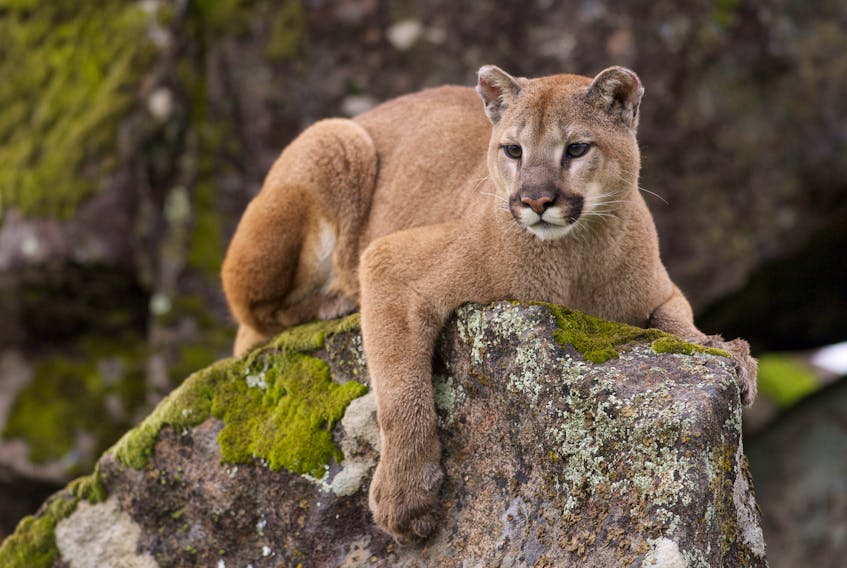The provincial government has documented around 80 reported sightings of large black cats or tawny-coloured cougars that date back to the early 1960s.
In light of more reports in western Newfoundland this fall, The Western Star decided to file a freedom of information request to see just what the provincial government has on record.
The resulting information provided includes a list of referenced cougar observations that spreads out over 14 pages and covers nearly every corner of the island of Newfoundland.
While the first entry is dated as being reported in 1981, the observation referenced is dated as either February or March 1960 or the spring of 1961. It has to do with the previously reported story of American hunters who allegedly released cougars in the Main Brook area so they could hunt them.
According to the official report, it is alleged that two American doctors transported three cougars, two females and one male, from Idaho. The story is that the hunters had to vacate their camp because of stormy weather.
The government report states that a secretary or nurse of the doctor corroborated the story, but only fox tracks were discovered around the cabin where the doctors were staying.
While no concrete evidence of cougar was found at their camp, the report does indicate there were large cages — drums, actually — and strange tracks reportedly found at the cabin, along with fur in the cages, though the report says the fur was presumably not collected.
The report also notes that enforcement officers stopped a party of Americans flying out of the airport in Gander and that the hunters confessed to having released fox for their hunt.
The government record’s conclusion was that this report involved suspicious activity, but unproven to involve cougars.
The government record also includes an anecdote reported previously by The Western Star in 2014 and originally published in the quarterly nature magazine The Osprey in March 1994. That story recounts an incident alleged to have happened near Port Rexton on the Bonavista Peninsula in 1986 in which two men claim to have struck and killed a cougar with their car and hauled the carcass off the road, only to find it missing when they went back later to examine it further.
The article in The Osprey noted how cougars have been known to drag away the remains of their own.
One entry references a report of a magician having a cougar in captivity, which may be the source of a rumour that a travelling circus once lost a cougar on the island. There is no specific year noted for this report and it also lists the possible location of Bay St. George as questionable.
That report mentions the information provided came from an SPCA group, but was second-hand to them.
Related stories:
Pasadena man driving effort to try to capture footage of reported wild cats in Newfoundland
The records provided by government include a dozen or so reports of sightings from the Fortune Head area of the Burin Peninsula between Aug. 11-23, 1988, though hair samples taken from the location of most of those sightings proved to belong to a lynx and not a cougar.
In some of the reports, including some in which photos were taken, the observed animal turned out to be a lynx or even a domestic cat.
In one reported incident from Garnish on the Burin Peninsula, where multiple sightings have been reported, the witness said the animal stalked them, sniffing the air for scent. The witness, who said this encounter happened in September 1988, reported throwing rocks at the cat until it went into the woods.
Most of the sightings, though, report a large, tan or light brown cat-like animal with a long tail. While the lynx that are native to the island match the colour often described, the presence of a long curly tail doesn’t jive with the short stubby tail characteristic of the lynx.
One of the major criticisms leveled by those who do not believe there are any cougars on the island of Newfoundland is the lack of photos, videos or physical evidence such as fur, scat or paw prints.
The government document indicates someone who observed a big cat in the St. John’s area in the1990s took a photo, but that image was never provided. Another report of a large cat with a long tail allegedly seen in the Happy Adventure area near Terra Nova National Park in 2005 vaguely indicates there is a “picture on file somewhere.”
Some of the reports, including the most recent from the Deer Lake area this fall, describe the large cat as being black. That also matches the description provided by a conservation officer who reported seeing one 15 feet in front of the officer’s truck.
Reported in the Ocean Pond area of the Avalon Peninsula in 2012, the animal seen was described as juvenile looking with a clumsy walk, standing only about two feet high with a long tail that was maybe 18 inches long.
If there are cougars on Newfoundland, there is a project now in the works to try and capture images of them. As reported earlier this week in The Western Star, 15 cameras will be distributed across the island in areas where cougars are suspected to possibly frequent with the hope their motion and body heat will trigger the cameras and finally capture the proof that has so far been too elusive.









